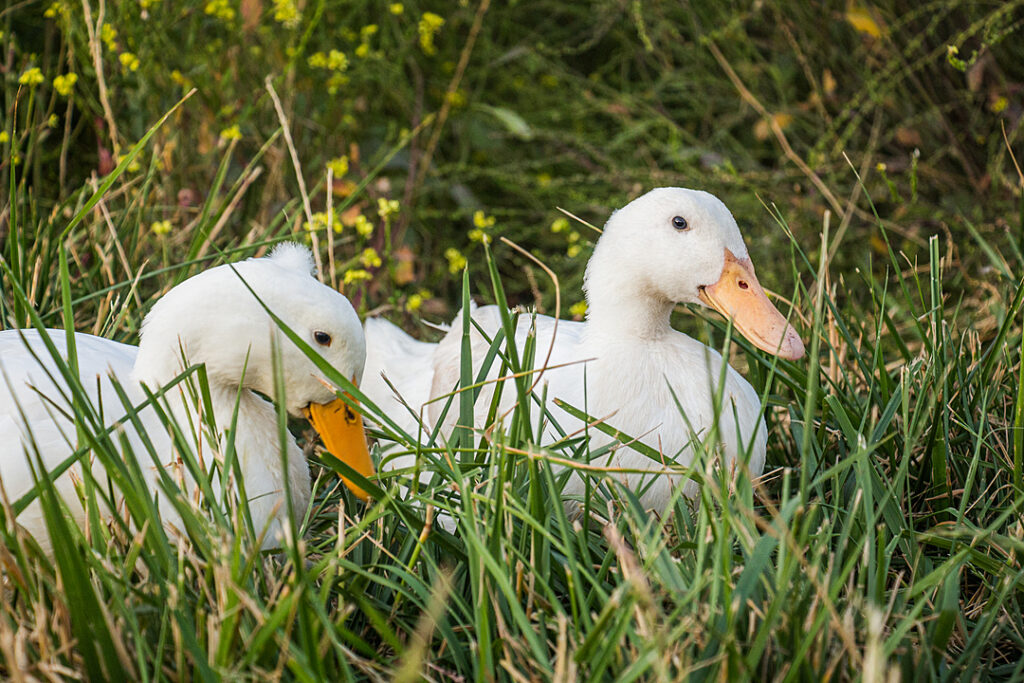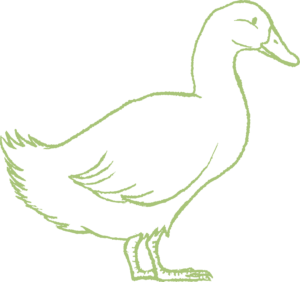
This resource has been updated as part of the veterinary review process. It was originally published in July 2019.

Veterinary Review Initiative
This resource has been reviewed for accuracy and clarity by a qualified Doctor of Veterinary Medicine with farmed animal sanctuaryAn animal sanctuary that primarily cares for rescued animals that were farmed by humans. experience as of May 2023.
Check out more information on our Veterinary Review Initiative here!
Much like the common advice given to humans, it’s important to regularly evaluate the health of ducksUnless explicitly mentioned, we are referring to domesticated duck breeds, not wild ducks, who may have unique needs not covered by this resource. with a routine health checkThe Open Sanctuary Project uses the term "health check" to describe health evaluations performed by caregivers who are not licensed veterinarians. While regular health checks are an important part of animal care, they are not meant to be a replacement for a physical exam performed by a licensed veterinarian. rather than waiting until a bird is showing signs of distress or illness. Conducting regular health checks will help you get to know what all aspects of a healthy duckUnless explicitly mentioned, we are referring to domesticated duck breeds, not wild ducks, who may have unique needs not covered by this resource. look and feel like and will also help you to establish a baseline for what is “normal” for each individual in your care. Not only this, but regular handling may help residents become more comfortable with restraint and human handling. Be prepared to check duck residents over at least every six to eight weeks*! For more information on why regular health checks are important, check out our resource here.
*A Health Check Every Six to Eight Weeks Means Daily Observations!
Our recommendation to conduct routine health checks every six to eight weeks must be done in conjunction with daily observations. Caregivers should be trained to observe animals both for behaviors that are abnormal for the species and also behaviors that are abnormal for each individual, keeping in mind issues that are common in a particular species or breed and their warning signs. Thoughtful observation plays a crucial role in catching health issues before they progress into more serious situations. You can read more about daily observation for duck health and well-being here.
Residents With Challenging Backgrounds
Close daily observation can be difficult with certain individuals or groups who come from challenging backgrounds. They may be more likely to hide signs of illness or injury, or may not allow you to come close enough to them to thoroughly assess their well-being on a regular basis. Challenging backgrounds may include individuals who are not socialized, have lived feral, or were abused or malnourished. If you care for individuals who came from a challenging background, it is imperative to make time to foster a bond of trust so careful observation is possible. A monthly health check is recommended for these individuals until they exhibit signs that they feel safe and you are confident that close daily observation is possible.

New Resident? Conduct An Intake Evaluation!
If you are conducting an initial health evaluation on a new resident, check out our intake evaluation resource to learn about what you should check for and document!
Supplies
Before conducting a health check, it’s helpful to gather any supplies you may need and have them arranged nearby for easy access. Having everything you will likely need nearby can make things go more smoothly and can reduce the amount of time the individual needs to be restrained. If you are performing a health check on someone with a known health issue, you may need to have additional supplies handy, such as those necessary to manage bumblefoot. Otherwise, general supplies to have on hand during duck health check include:
- Recordkeeping supplies
- Nail trimmers and/or dremel tool
- Styptic powder or other blood stop product
- Gauze squares (non-sterile is typically fine, but there may be times when sterile gauze is necessary)
- Exam gloves
- Bandage scissors
- Waterfowl-safe topical disinfectant (such as dilute chlorhexidine or dilute betadine)
- Saline flush
- Waterfowl-safe ointments or creams such as a triple antibiotic ointment or silver sulfadiazine cream 1% (SSD)
- Cotton-tipped applicators
- Tweezers
- Scale
- Headlamp, penlight, or flashlight
- Towels
- Antiparasitic treatment for external parasites, per your veterinarian’s recommendations
Conducting The Health Check

Ask an Expert
Prior to regularly conducting duck health checks, you should have your veterinarian or a compassionate care expert give you hands-on training in order to be the best duck health advocate possible. Being trained to rapidly distinguish abnormalities from normal anatomy and healthy conditions can be crucial in early health problem detection, and the sooner you are able to bring concerns to your veterinarian, the sooner they’ll be able to work towards making a diagnosis and recommending any necessary interventions!
Whenever possible, we recommend performing duck health checks in the morning before residents have had access to pools or ponds. This way, you’ll be able to catch things that may otherwise be cleaned off during the process of swimming or bathing such as fecal matting under the vent or ocular discharge.
Before beginning the actual health check, it’s a good idea to observe the individual without restraining them. Take note of their behavior, activity level, general appearance, how they are standing, and how they are moving. You can read more about “normal” versus potentially concerning duck resident observations here.
During regularly scheduled health checks, your goal is to check every inch of the duck. It’s helpful to have a general order and routine that you follow each time because this can help ensure you do not miss a step. We recommend finding a system and order that works for you. However, because some areas naturally flow into others, it might not be helpful to think of the process as a linear list of areas to check. Instead, we think of it more as a choreographed routine, where checking one area flows into checking another area. By checking individual areas or body parts in isolation, you may miss important findings in the gray areas in between.
Throughout the course of the health check, it’s imperative that you monitor how the duck is doing by watching their breathing and that you take a break if someone appears overly stressed.
Safe Restraint
Before attempting to conduct a health check, make sure you know how to safely hold a duck. You can read more about safe restraint here. If possible, it can be much easier to conduct the health check with an extra person who can restrain the individual while you perform the health check. This is especially helpful for folks who are just starting out or when working with a resident who is particularly bitey. You must be very cognizant of a duck’s stress levels and breathing when handling them – by having an additional person who can focus on just restraint while you perform the health check, you can ensure that someone is paying close attention to how the individual is doing. If a duck ever seems to be very distressed, breathing heavily (especially open-mouth breathing), or cannot breathe comfortably, you must take a break and let them calm down. Whenever setting a duck down, do so very carefully! Their feet should be solidly on the ground before you let them go.
When In Doubt…
Unless you are a qualified veterinarian or have been trained to handle specific conditions, The Open Sanctuary Project strongly advocates that you promptly report any concerns you find during the course of a health check to your veterinarian (if you aren’t sure if what you are seeing is cause for concern or not, a more experienced caregiverSomeone who provides daily care, specifically for animal residents at an animal sanctuary, shelter, or rescue. may be able to help you, but if you are ever in doubt, we recommend erring on the side of caution and reaching out to your veterinarian). You should be the resident’s advocate, not their doctor! Additionally, routine health checks performed by a caregiver are not meant to be a replacement for a veterinary exam. The goal is to catch potential signs of concern as early as possible so you can bring concerns to your veterinarian. If necessary, they can then perform a more in-depth physical examination of the individual and can conduct diagnostic testing as needed.
Up next, we’ll go over important components of a health check:
In cold climates, red and swollen toe tips; stiffened digits that do not bend readily; blackened skin; or hard, black, scabby toe tips/webbing could be a sign of frostbite. If you suspect frostbite, be sure to move the duck into a warmer area and consult with your veterinarian. At the very least, the duck will likely require pain medications, but may need antibiotics or even surgical intervention depending on the extent of the damage. If a duck shows signs of frostbite, be sure to make changes to their living spaces to protect the rest of your residents.
Check their nails and trim or file them if needed.
Carefully check their range of motion, especially in their hocks, and check for crepitus (creaking, cracking, crunching, popping, or grating), pain, resistance, heat, or swelling. Because of the conformation of their legs, checking the range of motion in their knees and hips is more difficult. Stop your evaluation and contact a veterinarian immediately if you feel a large amount of crepitus with pain – this could indicate a fracture and could be made worse with ongoing manipulation. Consult with your veterinarian immediately if one of your residents has hot, swollen, or scabby joints, which could be a sign of infection. Never attempt to drain infected joints!
Check for wounds, signs of parasites (including fly eggs, which look like grains of rice), and prolapsed tissue. Be aware that males have a protrusible phallus which projects from the vent when erect. While it is normal for this tissue to extend from the vent on occasion, phallic prolapsethe falling down or slipping of a body part from its usual position or relations is also possible. In addition to the phallus, cloacal, intestinal, and oviductal prolapses are possible. If you see tissue protruding from the vent, it’s good to keep handling to a minimum to avoid causing them to strain and potentially prolapse more tissue. If an individual prolapses a very small amount of tissue while being handled, setting them down may be all that is needed for the prolapse to resolve. If this is not the case, or if there is more than just a very small amount of tissue prolapsed or if the prolapsed tissue appears unhealthy, contact your veterinarian for guidance. Not only can they help with addressing the prolapsed tissue, they can also perform diagnostics to determine the cause of the prolapse. Depending on the type of prolapse and cause, the stress of handling may make things worse. Because of this, it’s safest to use a carrier to move a duck with a prolapse so as to avoid further handling. If a large amount of tissue is prolapsed, KY Jelly can be applied on top of it while transporting to a veterinarian, which will help keep the tissue lubricated and potentially viable.
Anyone with feces-covered feathers should be cleaned and monitored. It’s good practice to always evaluate a duck’s abdomen if you find that they have fecal matting under their vent, as this can be the result of a distended abdomen. Be sure to contact your veterinarian if anyone has excessive fecal matting, diarrhea, or is showing other signs of concern.
If one of your residents has a distended, fluidy, or firm abdomen, or if you can feel hard structures in the abdomen, the individual should be seen by a veterinarian for evaluation. A distended abdomen could be a sign of a reproductive tract issue. While any duck, regardless of their sex or breed, can develop reproductive issues, females of breeds bred for egg production are especially prone to reproductive issues.
The duck’s wings should be checked for swelling, heat, abrasions, and other injuries. If their wing tips are scabby or their wing feathers are tattered, this could indicate they have a mobility issue and are using their wings for balance and support. Individuals with mobility issues may benefit from more regular checking of this area to ensure any issues are caught early.
Abrasions on the wings could also be a sign that residents are being injured by elements in their living space such as hardware cloth. Be sure to investigate the cause and make changes to the living space as needed.
Check along the keel for any sores. Keel sores should be treated early on, before they risk infection, and you should investigate the cause (for example, spending more time lying down due to a mobility issue).
Unlike galliformesOrder of heavy-bodied ground birds including chickens, turkeys, guinea fowl, quail, and peafowl, ducks do not have a true cropA crop is a pouched enlargement of the esophagus of many birds that serves as a receptacle for food and for its preliminary maceration., though their esophagus can expand to accommodate food intake. Despite this, there have been reports of “crop” issues in waterfowl, so be sure to gently feel around the base of the neck and look for signs of distention in this area.
Eyes – The duck should have wide open, clean, alert eyes and their pupils should be round and symmetrical. The eyes should be clear and free of any discharge or crusts. Be aware that ducks have a third eyelid (also known as the nictitating membranea thin membrane found in many vertebrates at the inner angle or beneath the lower lid of the eye and capable of extending across the eyeball) that lubricates and protects the eye. You will likely see this membrane moving quickly across the eye but it should not be constantly visible. Cloudy, watery, dry, swollen, or crusty eyes are not normal. You should have your veterinarian evaluate any eye abnormalities as soon as possible.
Sinuses – Check the area around the eyes and in front of the eyes for any swelling.
Bill – Check the bill for any injuries or abrasions. If you have more experience with other species of birds, such as chickens, be aware that a duck’s bill is much softer than a chicken’s beak, and can be easily damaged, so use care when evaluating the bill and do not peel or pick at the bill as this can cause injury.
Nareseither of the pair of openings of the nose or nasal cavity – Their breathing should not be labored, loud, wheezy, rattly, whistling, or squeaky. Check their nares for discharge or buildup. In general, if you look into one nare, you should be able to see all the way out the opposite nare. However, the nares can become packed with food, mud, or other matter. If this is an ongoing issue, check that their water is deep enough for them to submerge their head so they can keep their nares clean. If using tweezers to remove something from their nares, use caution not to poke or scratch the bill or the nares. If you notice buildup on the bill around the nares, this could be dried nasal discharge. Do not peel this off as it may result in damage to the sensitive tissue of the bill. If this area needs to be cleaned, opt for a moistened cotton-tipped applicator or soft cloth.
Ears – The ear canal will be hidden by feathers and is located a bit lower and further back on the head than the eyes. The feathers around the ear should be clean and the canal should be free of discharge or debris and should not be inflamed or irritated.
Muscovy Mask
Unlike other ducks, muscovy ducks have featherless portions of the face that are larger and lumpier in males than females. While caruncles are often red, they can also be black or a mix of black and red. Check this area for any abnormalities or injury and be aware that this area is prone to frostbite, especially the large caruncle over the bill that some males get, so watch for discoloration during colder weather.
When you look inside their mouth, it should be moist but should not have excessive mucus. Their mouth should not have any ulcers, lesions, or areas of discoloration. Waterfowl naturally have many small bumps (papillae) on the roof of their mouth and along the sides of their tongue but make note of any unusual lumps or obvious asymmetry. Their breath shouldn’t have an overly strong odor – a sour smell could be a sign of sour crop. At the center of the back of their throat, is the glottis (the opening to the trachea). If the tongue blocks your view of this area, you can gently push down on the tongue. The glottis should open and close and the duck’s breathing should be quiet.
In general, feathers should be clean, though you may have residents who have dirty feathers from exploring in the mud or eating a messy treat. Unkempt or tattered feathers could be a sign of stress, external parasites, or unhealthy flock dynamics. Feather damage on the back of the head and neck of female residents is typically the result of being mounted. Be sure to keep an eye on mounting behavior as females can be injured during the mounting process and repeated mounting can result in feather loss and damage to the skin in this area. If females are being over-mounted, you will have to make changes to their flock arrangements to ensure their safety (this may include the creation of all-male and all-female flocks).
Feathers can hide external parasites, skin issues, and injuries, so it’s important to closely examine each resident’s skin. However, because of their thick feathering, it can be difficult to do this. It may be easiest to check their skin on their legs, along their keel, around the vent, and on the underside of the wings. Skin should be translucent and soft. Make note of any scabbing, swelling, discoloration, or sign of external parasites. Since thoroughly checking their feathered skin can be challenging, it’s often helpful to take time to feel along their entire body, making note of any lumps or changes in texture and then further examining those areas. This is the time to ensure you are checking and feeling every area of the individual’s body, not just those highlighted above. This thorough portion of the health check process is critical to ensure that nothing that can be addressed early is missed.
To weigh duck residents, it can be helpful to use a scale intended for “dynamic weighing” or “weighing in motion”, as these scales will calculate the average weight for an animal moving around on the scale rather than oscillating indefinitely. Baby scales also work well, and most have a “hold” feature that will lock in the weight reading rather than having the displayed weight change as the individual moves. Some caregivers prefer placing residents in a deep basket lined with a towel and using this to weigh them. This works best when using a scale with a large, flat platform so that the basket sits flat. Just be sure to zero out the scale so that it only displays the weight of the duck and not the duck plus the basket. If your scale does not have this capability, you will need to subtract the weight of the basket from the displayed weight to determine how much the resident weighs.
If weighing the duck in a standing or sitting position, make sure they have adequate traction on the scale (a bath mat or rubber bowl can be used to provide traction) and keep your hands near them to prevent them from slipping or jumping off and injuring themselves. We recommend weighing bigger ducks and anyone with heart, respiratory, or reproductive issues in a standing or sitting position. Smaller ducks may be able to be placed on their side or back – just be sure to watch them closely to ensure they do not have an adverse reaction to being in this position, and keep your hands near them in case they struggle.
In addition to weighing each individual, you should also pay close attention to their body condition to determine if they are at a healthy weight, as described above in the “Checking Their Breast And Keel” section. You might also ask that your veterinarian train you in body condition scoring. Unfortunately, monitoring their weight alone is not a perfect indicator of health. Some health conditions, such as reproductive issues, could result in an individual having a seemingly healthy weight based on the number on the scale, but a check of their body condition may reveal emaciation. Therefore, it’s important to pay attention to both weight and body condition to get a fuller picture.
When in doubt, grab a fecal sample and connect with your veterinarian.
A sick duck who is isolated from their flock may become more stressed, which could delay recovery. However, if the duck is being bullied or cannot compete with the rest of the flock for food, or if you need to more closely monitor their food and water intake and fecal output, you may need to separate them at least temporarily. You may find that keeping them in a quiet space with their closest companion is a good compromise until they are well enough to rejoin the flock and/or until you’ve gotten the all clear from your veterinarian.
To read more about considering alternative living arrangements in response to a health condition, check out our resource here.
Though it may seem like an overwhelming amount of factors to be aware of, once you’ve gotten to know your duck residents and what good duck health looks like, you’ll be an excellent duck health ally in no time!
Writing It All Down
As you may know, regular documentation is a critical part of responsible sanctuary animal care. In order to maximize the value of your duck health checks, we’ve developed a free printable duck health check form for sanctuaries and rescues!
Article Acknowledgements
Our deepest gratitude to Farm Bird Sanctuary, Little Bluestem Sanctuary, and Sophia DiPietro of All Species Kinship (A.S.K.) for sharing their duck caregiving knowledge and experience with us.

SOURCES:
BSAVA Manual Of Backyard Poultry Medicine And Surgery (Non-Compassionate Source)
Management Of Waterfowl | Gwen B. Flinchum, BS, MS, DVMDoctor of Veterinary Medicine, an academic degree awarded to veterinarians in many countries. (Non-Compassionate Source)
Non-Compassionate Source?
If a source includes the (Non-Compassionate Source) tag, it means that we do not endorse that particular source’s views about animals, even if some of their insights are valuable from a care perspective. See a more detailed explanation here.








